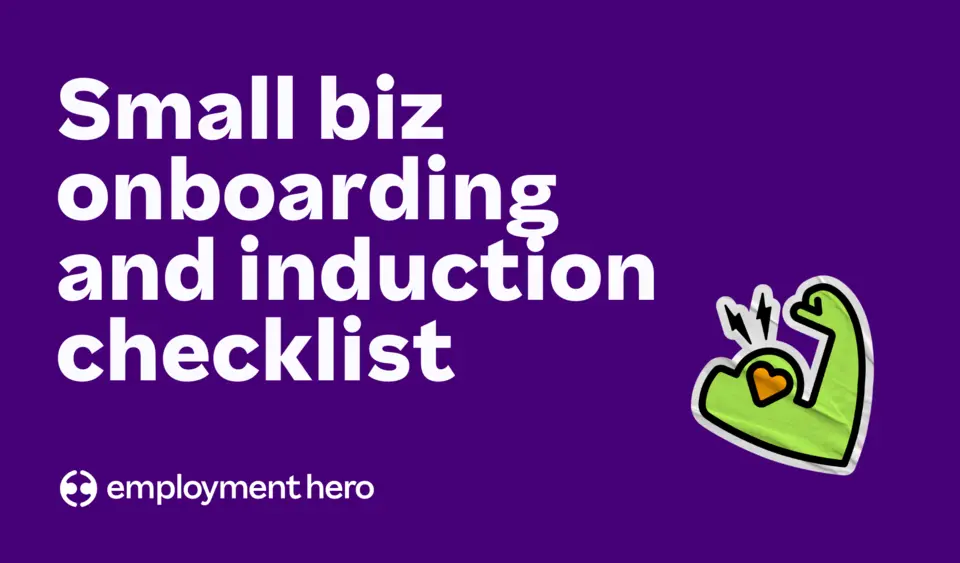Mastering OKRs: A Guide to Effective Objectives & Key Results
Published
Mastering OKRs: A Guide to Effective Objectives & Key Results
If we told you there was a practical way to align everyone in your company to one big ambitious goal, would you believe us? There’s no catch or secret, it simply comes down to a whole lot of dreaming and implementing OKRs.
If the OKR methodology is new to you, don’t fret – the OKRs framework has only risen to fame in the last 20 or so years after OKR advocate John Derr introduced this management methodology to the team at Google in 1999.
Google grew from 40 employees to its current 60,000 employees off the back of this performance management framework. Silicon Valley rapidly adopted this highly-effective people strategy, and now OKRs are used in some of the world’s most innovative companies.
Cool story, huh?
With some of the world’s biggest companies using the OKR goal-setting framework, we think more businesses need to know what the fuss is all about and everything about how OKRs work.
We wrote this ‘OKRs: Explained’ guide to do just that!
If you’re managing a hybrid work environment, implementing OKRs can be particularly beneficial.
What is in this OKR guide?
Our OKRs guide is jam-packed with useful advice, such as:
- What are OKRs?
- Why use OKRs?
- OKRs vs. KPIs
- How to avoid common OKR mistakes
- OKRs advice for leaders
Download the free digital copy of the OKR guide now.

What are OKRs?
So what are OKRs? In what ways are your OKRS influencing your top company objectives? How can you use them in your business and just why are they so damn great anyway?
Let’s dive in!
OKRs stands for:
- (O)bjective
- (K)ey
- (R)esults
OKRs consist of an Objective, which defines a big goal to be achieved (the ‘what’ or ‘where do we want to go’), and up to five Key Results, which measure progress towards the objective (‘how do we know we’re making progress?’).
Each Objective Key Results can also have Initiatives, which describe the work required to drive progress on the key results. We suggest starting with a maximum of three to five key results and adding more as your company gets familiar with the OKR framework.
OKRs are created top-down and bottom-up. The only top-down OKRs should be your company-level OKRs.
From there, it’s up to each person and/or team to write OKRs for their team, together.
This gives your employees the opportunity to have a say in how they, in their role, will help to achieve the company OKRs. They are also designed to be publicly seen and set for everyone inside the business.
This means all employees, whether junior or senior, know what is expected of them. This transparency helps to cultivate a culture of trust and team spirit.
Why is goal setting important?
Goal setting improves performance, but if you start spending hours cascading goals up and down the entire company, they are not as effective. It takes too much time, and it’s hard to ensure all the set goals align with one another.
This is exactly why OKRs do not cascade in that way and instead work both ways. Objectives simultaneously go bottom-up and top-down. The company as a whole can set the strategic OKRs that each team should use to draft their individual and more tactical OKRs.
OKRs that are structured this way should make sure that each individual team’s OKRs are both agile and aligned with the company vision. This is how creating OKRs help improves team engagement whilst also creating a better understanding of the OKR process across the entire organisation.
By setting ambitious, actionable goals and making sure all employees know exactly how they are contributing to achieving the company strategy – your business is on the path to success.

OKRs vs. KPIs
We wouldn’t blame you if you thought that by writing OKRs, you would replace Key Performance Indicators (KPIs). While they both measure a business’s performance and success, there are a few key (sorry) differences.
OKRs are to help you achieve grand, ambitious goals. They’re designed with a crazily bold mission in mind rather than a specific measurable outcomes. It is a qualitative goal.
KPIs, on the other hand, are tangible outcomes with measurable results. It is a quantifiable goal.
For more insights on how leading companies utilize OKRs to drive success, check out our blog on how leading companies use OKRs.
Key Performance Indicators (KPIs)
Key Performance Indicators (KPIs) have been the flavour of choice for performance management for some time now, so they really need no introduction… however, in case some millenials have found their way to this blog, we’ll include a definition anyway.
KPIs vary from role to role and goal to goal, but essentially, they are clearly defined goals with measurable metrics that define your success.
In HR management, common KPIs can be:
- Absence rates or costs
- Employee satisfaction
- Turnover rates
Business owners, they’re likely to keep an eye on the total profit margins, revenue growth rate, net promoter score or inventory turnover – on top of everything else!
KPIs monitor the individual performance of employees. In the above example, a cashier isn’t going to be concerned with profit margins – their KPIs might be the number of customers they serve in an hour or the results of a customer satisfaction survey.
The main benefit of KPIs is that they identify areas that need improvement, but they rely on the leadership team to ensure that KPIs are kept front of mind. Because KPIs are individual targets, they can easily be forgotten if managers don’t hold their team accountable.
Objective Key Results (OKRs)
Like KPIs, Objectives and Key Results also bring focus to the areas of the business that make the biggest difference. Unlike KPIs, OKRs are team objectives that are collaborative – operating on a company, team and individual level that promotes transparency and accountability for all employees.
OKRs switch the focus from results to aspirations or goals (aka ‘objectives‘) that can be achieved by fulfilling a number of important tasks (aka ‘key result‘).
Goal setting with the OKR methodology requires businesses, teams and employees to define their desired destination, the achievements that will confirm (or deny) their arrival and the time they must arrive by.
It also requires companies, individuals or teams to articulate what initiatives they will take to get there (yes, there’s another step not included in the acronym, but OKRIs just don’t have the same ring to it!).
Remember, objectives aren’t measurable. They are ambitious goals or aspirations that are attained by completing the key results.
Are KPIs better than OKRs?
Both KPIs and OKRs have earned their rightful place – you just have to be strategic about what to use and in what scenario.
OKRs are about changing processes. Whether you’re troubleshooting a problem within the business or wanting to grow and innovate, use the OKR system as a strategic framework to enact change.
Your KPIs may help you decide on what the key results for new objectives will be, but they aren’t part of the process. Consider your KPIs as a baseline; they indicate that everything is going well and there are no issues that need to be addressed.
If your KPIs start to slip, that means something’s going wrong – you can use OKRs to get back on track. After you identify an area of the business that needs improving, it can become its own OKR.
Regardless of which framework you are implementing, 1:1 meetings are a great tool for keeping the team on track with progress. We’ve created a handy 1:1 meeting template so you can get started today!
How KPIs can help track progress of OKRs
For example, if an HR manager noticed that the company’s retention rates were dropping, they could make their objective to improve employee satisfaction.
Key results could include:
- Increase overall employee satisfaction by X%, as measured by weekly employee happiness surveys with a 50% participation rate;
- Implement a peer-to-peer recognition programme with over 100 individual pieces of recognition over the quarter;
- Reduce voluntary turnover by 20% in the next six months.
Note that the objective (improving employee satisfaction) isn’t measurable, but the key results are.
An HR Manager would then break down the key results even further into initiatives.
For example, for the first key result, Increase overall employee satisfaction, as measured by weekly employee happiness surveys, initiatives could include:
- Research best employee engagement survey tools;
- Make the business case for an employee engagement tool;
- Launch surveys and communicate the ‘why’ to employees;
- Monitor participation.
Without monitoring the turnover rates, the HR Manager wouldn’t have known a change was needed. The business would have had a high turnover. Turnover is expensive, so the more it happens, the more it eats into your margins.
Unpack more in our Talent Insights Report if you’re looking for retention strategies.
The issue with using only KPIs
The problem with only using KPIs is that there is a lack of visibility. If the CEO wasn’t meeting regularly with the HR Manager, and the HR Manager wasn’t engaged enough to monitor their KPIs, the business would have suffered. Using KPIs to accurately measure productivity is only possible if employees and managers alike are on the ball. For the record, we’re encouraging collaboration, not micromanagement.
OKRs, on the other hand, are collaborative. Each employee should have at least one goal that contributes to the team goal, and team goals should have at least one goal that contributes to the company goal. And because key results are assigned to owners, employees are more accountable for their output, and this is visible across the business.
If you’re using Employment Hero’s Goals module, then anyone in the company can view their colleagues’ OKRs, as well as the company-wide goals. This improves the visibility of the team OKRs to individual employees, as the goals and vision for the company are easily communicated.
This is how OKRs can be used to measure HR effectiveness alongside KPIs.
Not ‘either/or’, but both
As you can see, comparing OKRs and KPIs is like comparing apples to oranges. OKRs and KPIs serve different functions. KPIs measure performance, whereas OKRs are a framework that businesses can use to change processes or outcomes for the better.
You should always keep an eye on your KPIs, but OKRs are your pathway to growth.

How to write your own OKRs
Now that we know what they are and why every business should be using them, let’s dive deeper into the OKR formula. Let’s look at the best ways to structure and set your business OKRs so you get the most out of them.
Step 1: Start with your big hairy audacious goal (aka. The BHAG)
A BHAG is an ambitious, long-term goal that pushes an organisation beyond its limits and inspires everyone in the team. BHAGs serve as a unifying force, guiding strategic decisions and driving innovation by putting focus on the entire organisation into the same objective. Examples include NASA’s moon landing and Google’s mission to organise the world’s information.
We believe every company should have a BHAG that helps them set a huge, awe-inspiring mission for the future. If your company isn’t there just yet, that’s okay!
Perhaps you can start by looking at your 1, 5, or even 10-year plan for the company, what do you want to have achieved by each point? This will give you the best chance at setting aspirational high-level objectives.
An OKR describes both what you will achieve (objectives) and how you are going to measure its achievement (key results). This makes OKRs a highly effective goal-setting technique. Being able to make an accurate measurement is what makes a goal achievable.
So how do you go about setting individual OKRs for functional teams?
Let’s break it down further:
Step 2: Define your company’s Objectives
What is your desired outcome? Where do you want to go? Your objective is your big goal. We’ll use the example of a fictional bakery, The Frosted Frenchman.
The Frosted Frenchman wants to be known for having the best croissants in Australia.
Their objective is now: ‘Have the Best Croissants in Australia’. 
Step 3: Create measurable goals (Key Results)
What do you need to do to achieve the objective? How are you going to get where you want to go? Your key results are the actions you need to take to reach your top company objectives.
If we go back to the bakery analogy, the key results are your benchmarks of success. So for The Frosted Frenchman, one of their key results would be: ‘Win 3 bakery awards this year’.
Step 4: What are your OKR Initiatives?
As we mentioned earlier, Initiative is part of the OKRs process and is important in ensuring the success of your key results. Initiatives sit under key results as the activity that was taken to achieve them.
An initiative can be considered as the actual steps you take, like, ‘Enter 10 competitions this year’, or, ‘Taste and research prior winner’s croissants’. Put simply, your initiatives are a to-do list of how you achieve your key results.
Summary of the OKR process
Considering the analogy above, you can see how the OKR is broken down into logical steps.
The Frosted Frenchman wants to be known for having the best croissants in Australia (Objective), so what do they do?
They need certain things to happen, like winning awards for it (Key Results).
Finally, what do they need to do to win those awards? (Initiatives).
OKR examples and tips
Now that you understand what OKRs are and how to write them – here are some tips when setting OKRs. We’ve also got some Objective and Key Results examples.
Objectives should be
Directional – Objectives tell you where to go (key results tell you how to get there).
Memorable – Objectives need to be memorable and have qualitative descriptions of exactly what you want to achieve.
Brief – Objectives should be simple, short, inspirational and engaging. Aim for one line.
Inspiring – Objectives should be crafted in a way that inspires and motivates employees by challenging them to reach their full potential and aligning their efforts with a meaningful and compelling vision.
Examples of good Objectives
Objectives for marketing
- Generate X high-quality leads and conversions (MQLs)
- Increase brand awareness and reach
Objectives for sales
- Hit and increase revenue target and market share by X%
- Improve customer retention by X%
Objectives for product teams
- Successfully launch feature release by X date
- Improve product quality and user experience (UX)
Key Results should be
Measurable – Key results are a set of metrics that measure your progress towards an objective. Make them quantitative and measurable with metrics that clearly show their progress.
Simple – Limit each objective to 2-5 key results to keep it actionable.
Achievable – Key results for an objective are vital for achieving the objective at the end of the quarter. Make sure your key results are achievable in the time frame you have.
Challenging – Go hard, or go home! Key results are where your OKRs denote ambition. When writing your key results, try to make them a stretch. Metrics should be bold but achievable – this is how you embrace growth.
Examples of good Key Results
Key result for marketing
- Achieve a X% increase in website traffic from organic search and social media referrals within the next quarter
- Attain a X% increase in the conversion rate of marketing-qualified leads (MQLs) to sales-qualified leads (SQLs) through lead nurturing efforts within the next six months
Key result for sales
- Achieve a X% increase in monthly sales revenue in the target market within the next quarter
Key result for product teams
- Increase Apdex score to 0.8
- Conduct 16 testing sessions with target users
Common OKR mistakes to avoid
1) OKRs are not a to-do list
Use OKRs to measure if you are adding value, not if you’re delivering tasks. You can create a to-do list around how you will complete key results as quarterly objectives if this helps you break them down.
But if you start using OKRs as your to-do list you might start feeling slightly disheartened at the end of each day when you haven’t ticked much off.
Most companies run quarterly OKRs and are bigger goal measurements than your Asana list or Trello board.
2) Don’t set too many OKRs
Your OKR list should be this quarter’s top business priorities and the definition of what is most important during the quarter. If you start creating too many OKRs, employees will start to feel disengaged, unmotivated and uninspired by lists of rambly OKRs going in all directions.
3) Make sure your OKRs are aligned
OKRs should be used as a company alignment tool, so you should never set your OKRs in isolation. You should talk to the other teams in the business, as well as all employees individually, to make sure all OKRs are connected to achieve the overarching company goals or vision. Collaboration and transparency are key.
4) “Set it and Forget it.”
OKRs are by design, agile. You need to keep checking on your OKR progress to make sure that your goals and objectives still align with changing priorities. Setting and forgetting hinders accountability and engagement, and limits the opportunity for ongoing learning and improvement. That’s why regular check-ins, feedback, and adjustments are essential to keep OKRs relevant, as well as to maintain motivation and adapt to evolving circumstances. Aim for x timeframe.
Achieving ambitious OKRs with Employment Hero
We liked OKRs so much that we made sure they became a key feature in Employment Hero’s all-in-one HR software. You can use our built-in OKR tools and OKR templates to successfully implement OKRs for your business.
To find out more about Employment Hero’s OKR feature, book a demo and see it in action today.
Download the OKR guide today for bonus tips for leaders thinking of implementing OKRs. Share the eBook with your team members, and get started with goal setting in no time!
Related Resources
-
 Read more: Recruitment compliance do’s and don’ts: Hiring compliance for hiring managers
Read more: Recruitment compliance do’s and don’ts: Hiring compliance for hiring managersRecruitment compliance do’s and don’ts: Hiring compliance for hiring managers
Published 1 min read Having responsibility for a business’s approach to hiring can be daunting: how do you ensure all…
-
 Read more: Hiring Issues Holding You Back? The Business Owner’s Guide to Competing for Top Talent
Read more: Hiring Issues Holding You Back? The Business Owner’s Guide to Competing for Top TalentHiring Issues Holding You Back? The Business Owner’s Guide to Competing for Top Talent
Published 1 min read Hiring great people is one of the most powerful ways to grow your business – but…
-
 Read more: Dodge Thousands in Fines, Keep Great Staff: Onboarding Checklist
Read more: Dodge Thousands in Fines, Keep Great Staff: Onboarding ChecklistDodge Thousands in Fines, Keep Great Staff: Onboarding Checklist
If you run a business with under 10 staff, this onboarding checklist will help you get the most out of…











